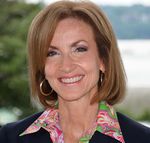2021 Second Quarter in Review - Goodman Institute
←
→
Page content transcription
If your browser does not render page correctly, please read the page content below
2021 Second Quarter in Review
In this quarter, the Goodman Institute, in partnership with the Heritage Foundation, rolled out an
Agenda on Health. Designed as a roadmap for policy makers who favor free-enterprise reforms, the
document had input from Newt Gingrich, key members of Congress, and others. Also, Professor
Laurence Kotlikoff has produced a first-of-its kind study on inequality in the US – finding that the issue
has been greatly exaggerated.
Supreme Court Punts Obamacare Back To Us
The highest court has spoken: Obamacare is constitutional. If changes are needed, look to Congress,
not to the courts.
Obamacare has two very bad features: unaffordable out-of-pocket costs, and perilously narrow
networks.
If you combine last year’s average (unsubsidized) premium with the average deductible, a family of
four had to pay $25,000 before getting any benefits at all from their plan. Also, the average plan looks
like Medicaid managed care with a high deductible, excluding access to the best doctors and the best
hospitals.
This was the predictable outcome of a sort of Wild West version of managed competition. In fact,
Goodman Institute President John Goodman predicted these problems a decade ago. Yet folks on the
left and the right have been slow to find solutions. Candidates who have credible solutions will have an
edge in the next election.
At Forbes, Goodman argued that the solution to high out-of-pocket
costs is to let people buy insurance that meets their medical and
financial needs. The solution to narrow networks is a risk-
adjustment system that looks very much like the (Republican
created) Medicare Advantage program – one that makes sick
enrollees just as attractive as the healthy.
At the Heritage Foundation’s Daily Signal, Goodman argued that
the defects of Obamacare are spurring the rapid enrollment in
health insurance alternatives.
Book Awards
John Goodman’s book, New Way to Care: Social Protections that
Put Families First, has just won a number of book awards:
2021 Independent Publisher Book Awards: Winner: Silver
Medal for Best Book in Finance/Investment/Economics
2021 Next Generation Indie Book Award: Finalist: General
Non-FictionHealth Care Agenda
The Health Care Agenda is a joint project of the Goodman Institute and the
Heritage Foundation – produced under the leadership of John Goodman and
Marie Fishpaw (director of domestic policy at the Heritage Foundation).
Patterned after the original Newt Gingrich Contract with America, the idea is to
give conservative candidates some simple, easy-to-remember reforms to
campaign on.
This is a work in progress, and we continue to make changes as we get feedback.
Marie Fishpaw
We have had input from Gingrich and his staff, the House Republican Study
Committee, and others.
Goodman and Fishpaw, along with Rep. Chip Roy the
point person on health for the House RSC), Joe
Desantis (Newt’s health guy), and Kansas State
Senator Beverly Gossage presented the ideas to the
Heritage Resource Bank meeting in Austin. The
reception from the think tanks and the activist groups
who attended was overwhelmingly positive.
Here are a few of the ideas:
End Obamacare’s narrow networks, which are
denying patients access to the best doctors
and the best care.
End Obamacare’s unaffordable deductibles Chip Roy and John Goodman
and premiums, and let families have access to
insurance that meets their medical and financial needs.
Let workers have access to personal, portable health insurance that travels with them from
job to job and in and out of the labor market.
Expand virtual medicine, so that patients can get more care in their own homes.
Give families access to 24/7 primary care, so they can avoid the emergency room at nights and
on weekends.
Better Than Biden’s Family Plan
The American Families Plan will cost $1.8 trillion. It includes child care, pre-school, paid family and
medical leave, and much more.
Yet instead of borrowing huge sums of money and leaving the debt for our children and grandchildren
to pay, why don’t we liberate families instead?
Uber has shown us what can happen when government mainly isn’t involved. Uber drivers have all the
flexibility that the Biden administration wants workers to have – and they like it that way. When they
need to take time off, they take time off. When they are free of family responsibilities, they work and
earn money.So why don’t more people work as independent contractors, like Uber drivers? Federal law discourages them from doing that. They get a smaller tax break for health insurance, retirement savings, and day care expenses, for example. Wall Street Journal columnist Kimberley Strassel and John Goodman wrote about these inequities and many more in the book Leaving Women Behind: Modern Families and Outdated Laws. Goodman Institute board member and former member of Congress Nan Hayworth updated the numbers in a Goodman Institute Brief Analysis. And John Goodman dissected the Biden pans in a recent editorial at Forbes. Nan Hayworth Pete du Pont: 1935 - 2021 He believed “ideas could change the world” In 1988 he ran for president on a platform that included school choice, welfare reform, and Social Security privatization. Although his bid was unsuccessful, his ideas appealed to others. Congress passed welfare reform under President Clinton. George W. Bush created a bipartisan commission that recommended private Social Security accounts. And school choice experiments sprouted in practically every state. One of his advisors was economist John C. Goodman, president of the National Center for Policy Analysis (NCPA) in Dallas. Following his presidential run, du Pont joined the NCPA and became its chairman from 2004 to 2012. Under his leadership, the NCPA championed such ideas as Health Savings Accounts, Roth IRAs, and letting seniors continue working without losing Pete du Pont their Social Security benefits. All three of those proposals became law. A forum to promote these and other innovative reforms was William F. Buckley’s Firing Line program. Goodman and DuPont appeared on about two dozen programs, including a number of two-hour debates where they teamed with Buckley to debate such liberal opponents as former presidential candidate George McGovern, Sen. Jay Rockefeller, and economist Lester Thurow. “Pete was one of the very few politicians who could debate serious topics with serious people and hold his own along the way,” said Goodman. In 1996, du Pont joined with Goodman and Peter Orszag, to make the case for pension reform. Orszag was an economist with the Brookings Institution who later became Congressional Budget Office Director and then Chief Economist for President Barack Obama. The three managed to bring Republicans and Democrats together to pass legislation allowing employers to automatically enroll their employees in 401(k) plans with diversified portfolios – so that those employees would have larger and safer accumulations during their retirement. An estimated 16 million employees are now benefiting from this reform. “Pete du Pont was a man of ideas. He didn’t do a poll of voters to decide what he stood for. He searched for reforms that worked and then tried to coax the public to follow him. He was one of the truly remarkable political leaders of the 20th century,” said Goodman.
Are The Rich Paying Their Fair Share Of Federal Taxes?
Judgments may differ, but one thing is certain. As a group, the rich pay the largest share of all. In 2018,
for example, the top 1 percent of taxpayers paid 40.1 percent of all federal income taxes. The top 10
percent paid 71.4 percent. The bottom half of the country paid almost no federal income taxes.
What about reports that some billionaires are paying zero taxes? Cherry picking the tax returns of a
few wealthy individuals is no way to understand the big picture.
In any given year, Warren Buffett could have zero or even negative income. But no one would consider
him poor. Buffett is rich, not based on his immediate income, but because he has massive resources.
Resources are the sum of net wealth -- assets less liabilities – and human wealth -- the value of future
labor earnings.
The latest analysis from Kotlikoff and his colleagues looks at lifetime taxes and lifetime government
transfer payments and concludes that our fiscal system is very progressive.
Take the top 1 percent of 40–49-year-olds (ranked by remaining lifetime resources). They account for
29.1 percent of that age group’s net wealth, but only 11.8 percent of the group’s remaining lifetime
spending. That’s almost a two-thirds reduction. By contrast, the lowest fifth of the distribution has just
0.4 percent of the group’s net wealth, but 6.6 percent of its total lifetime spending power. That’s a 16-fold
increase. Here’s another angle on these numbers. The top fifth of this cohort have, on average, 195 times
as much wealth as people in the bottom fifth. But in terms of lifetime spending, the ratio is just 7.5 to1.
What about taxes?
Consider, again, 40-year-olds. The top 1 percent face an average lifetime net tax rate of 34.7 percent.
That means 34.7 cents of every dollar of resources goes to Uncle Sam in taxes paid net of government
transfer benefits received. For those in the top 20 percent, the average remaining lifetime net tax rate
is 30.7 percent. But those in the bottom 20 percent face a negative tax. Every dollar of pre-tax income
is matched by a 44.4 cent net subsidy.
As Kotlikoff and John Goodman write in The Hill, concern over inequality is largely misplaced. Spending
inequality is one-third of wealth inequality, mainly because of our very progressive transfer system.
Outreach
The Goodman Institute sponsored a panel on “How to
Reform Obamacare” at the Association of Private
Enterprise Education in Fort Lauderdale in April. Joining
Dr. Goodman were Goodman Institute Senior Fellows
Linda Gorman and Devon Herrick, and Heritage
Foundation director of domestic policy, Marie Fishpaw.
In June, Dr. Goodman rolled out an Agenda for Health
Reform to the Heritage Resource Bank meeting in Austin.
Joining him were Rep. Chip Roy, Joe Desantis (health
policy expert for New Gingrich), and Marie Fishpaw.
John Goodman and Linda Gorman at the Association
of Private Enterprise Education meeting.
6335 W Northwest Hwy - #2111 • Dallas, TX 75225 • email: info@goodmaninstitute.org • +1 214.302.0406
The Goodman Institute for Public Policy is a 501(c)(3) nonprofit organization and contributions are tax-deductible to the fullest extent of the
law. A tax receipt will be issued directly from the Goodman Institute within 2 business days after the receipt of your donation.You can also read
























































